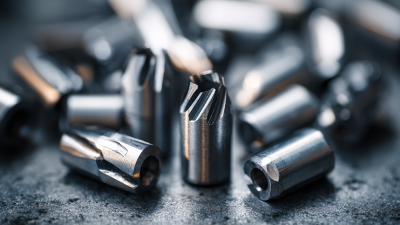Maximize Your Machining Efficiency with Quality Used Carbide Inserts: A Comprehensive Guide
Table of Contents
- Understanding Carbide Inserts: Types and Their Applications
- Key Benefits of Using Quality Used Carbide Inserts in Machining
- Evaluating the Quality of Used Carbide Inserts: What to Look For
- Tips for Maximizing Cutting Efficiency with Used Inserts
- Best Practices for Maintaining and Storing Carbide Inserts
- Enhancing Machining Efficiency: Insights from Industry Reports on Kyocera TPGH Ceramic Lathe Tips TPGH110304L TN60
- FAQS
- Conclusion
- Related Posts
In today’s pretty competitive world of machining, really nailing down maximum efficiency is key for manufacturers who want to boost their production while keeping costs in check. One strategy that’s been gaining a lot of traction is using quality Used Carbide Inserts. Lots of industry leaders are jumping on this bandwagon. In fact, according to a report from the Metalworking Industry Association, about 70% of manufacturers are now bringing refurbished tools like Used Carbide Inserts into their workflows. They’ve found it’s a solid way to cut down tooling expenses and get better machining results.
Industry expert Dr. Emily Tran, who’s pretty much an authority on cutting tools, stresses how important this approach really is. She says, “Investing in Used Carbide Inserts not only helps your tools last longer, but it also fits well with more sustainable manufacturing practices.” As companies look to produce more without blowing their budgets, sourcing Used Carbide Inserts smartly can really be a win-win — boosting productivity and helping the environment at the same time. In this guide, we’ll walk through the top five perks of using top-quality Used Carbide Inserts in your machining process, so you can stay ahead in this pretty competitive, demanding market.

Understanding Carbide Inserts: Types and Their Applications
Carbide inserts are essential components in modern machining, significantly impacting the efficiency and quality of manufacturing processes. Understanding the various types of carbide inserts and their specific applications can help machinists select the most suitable tools for their projects. These inserts can be categorized based on their functions, such as drilling, milling, and turning, with each type designed for particular tasks and materials. For instance, turning inserts are optimized for precise rotary cutting, whereas milling inserts excel in removing material from flat or contoured surfaces.
The identification system for indexable inserts, as outlined by the American National Standard, plays a crucial role in simplifying the selection and application process. This system helps machinists easily recognize the characteristics of, and the appropriate uses for, different inserts. Recent advancements in insert technology, including tougher grades and innovations in toolholder design, have further expanded the capabilities of machining tools. The introduction of new high-performance insert ranges allows manufacturers to tackle a broader spectrum of applications, enhancing overall productivity and machining efficiency.
Maximize Your Machining Efficiency with Quality Used Carbide Inserts: A Comprehensive Guide
| Insert Type | Material | Application | Coating | Edge Preparation |
|---|---|---|---|---|
| CNMG 120408 | Carbide | Turning | TiN | Sharp |
| SANDVIK R217.45 | Carbide | Milling | TiAlN | Chipped |
| WNMG 080404 | Carbide | Turning | CVD | Worn |
| TPG 322 | Carbide | Grooving | TiN | New |
| VCMT 16T3 | Carbide | Turning | ZrN | Re-sharpened |
Key Benefits of Using Quality Used Carbide Inserts in Machining
Using quality used carbide inserts in machining offers several key benefits that can significantly enhance operational efficiency. Firstly, these inserts maintain impressive durability and performance levels while being available at a fraction of the cost of new inserts. This cost-effectiveness allows manufacturers to allocate resources more efficiently, enabling investment in other essential areas of production or technology upgrades.
Another significant advantage of quality used carbide inserts is their environmentally friendly aspect. By opting for used inserts, businesses contribute to waste reduction and promote sustainability in manufacturing processes. This practice aligns well with the growing demand for eco-conscious operations in today's industrial landscape. Additionally, many used inserts have been reconditioned to meet stringent performance standards, ensuring that they can deliver results comparable to new inserts. This combination of cost savings and environmental responsibility makes quality used carbide inserts a smart choice for manufacturers aiming to maximize machining efficiency.

Evaluating the Quality of Used Carbide Inserts: What to Look For
When evaluating the quality of used carbide inserts, several key factors should be taken into account to ensure optimal machining efficiency. Firstly, inspect the insert’s cutting edges for wear and chipping. According to a recent industry report by the Cutting Tool Engineering, inserts that display minimal wear can significantly prolong tool life by 30% compared to their heavily worn counterparts. Additionally, examining for signs of thermal cracking can indicate past improper usage or overheating, which impacts performance.
Tips: Look for inserts with a coating that shows minimal erosion. Coated carbide is known for its enhanced hardness and resistance to wear, making it crucial for high-speed applications. A Siemens Productivity Report highlights that using quality coated inserts can reduce machining time by up to 25% while maintaining finish quality.
Furthermore, consider the insert’s overall geometry. Inserts designed for specific applications—like turning, milling, or drilling—provide better performance metrics. The International Journal of Advanced Manufacturing Technology states that utilizing the correct insert geometry can lead to a 40% increase in feed rates. Therefore, always verify the insert's specifications against your machining requirements to ensure a successful outcome.
Tips for Maximizing Cutting Efficiency with Used Inserts
Maximizing cutting efficiency with used carbide inserts can significantly enhance your machining processes without straining your budget. The first step is to select inserts that have been well-maintained and show minimal wear. Ensure that they have been properly stored and are free of any damage that could compromise performance. Conduct thorough inspections to identify the inserts that best suit your specific machining demands, focusing on geometry and coating that align with the materials you’re working with.
Additionally, optimizing cutting parameters is crucial when using quality used inserts. Adjusting feed rates and cutting speeds can lead to improved tool life and surface finish. Start with conservative settings and gradually increase as you monitor performance. Regularly check for signs of wear, such as chipping or edge degradation, and replace inserts promptly to maintain efficiency. By employing these strategies, you can successfully leverage used carbide inserts to achieve effective and economical machining solutions.

Best Practices for Maintaining and Storing Carbide Inserts
When it comes to maintaining and storing carbide inserts, implementing best practices can significantly extend their lifespan and improve machining efficiency. According to a report by the National Tooling and Machining Association, proper maintenance can increase the usable life of carbide inserts by up to 30%. Regular inspection for signs of wear, such as chipping or cracking, allows for timely replacement, which can prevent costly downtime in manufacturing processes.
In addition to maintenance, storage conditions play a crucial role in preserving the integrity of carbide inserts. The American Society for Precision Engineering recommends storing these tools in a controlled environment, where humidity and temperature fluctuations are minimized. Ideally, inserts should be kept in dry, clean containers, away from direct sunlight, to prevent corrosion and deterioration. A systematic inventory management approach, where inserts are cataloged and rotated based on use, can also optimize their performance and longevity, leading to more consistent machining results. By adhering to these practices, manufacturers can maximize the effectiveness of their carbide inserts, ultimately leading to improved production efficiency and reduced costs.
Maximize Your Machining Efficiency with Quality Used Carbide Inserts
Enhancing Machining Efficiency: Insights from Industry Reports on Kyocera TPGH Ceramic Lathe Tips TPGH110304L TN60
In the ever-evolving landscape of manufacturing, enhancing machining efficiency is imperative for staying competitive. One standout solution has been the Kyocera TPGH ceramic lathe tips, specifically the model TPGH110304L TN60. These tips are ingeniously designed to optimize machining processes, making them a preferred choice in various industrial applications. Their reliability and performance have been validated by numerous industry reports, highlighting their effectiveness in improving productivity.
The Kyocera ceramic lathe tips are an original product from Japan, renowned for their superior quality and precision. They are particularly well-suited for machining steel, demonstrating exceptional durability and cutting performance. Furthermore, Kyocera offers a wide range of products tailored for cutting, milling, and threading, ensuring that manufacturers can find the perfect tool for their specific machining needs. The stability and security afforded by these lathe tips instill confidence in operators, allowing for higher throughput and reduced downtime during production processes.
The insights gleaned from industry reports underscore the significance of utilizing Kyocera TPGH ceramic lathe tips in manufacturing settings. By investing in these high-quality tools, businesses can enhance their machining efficiency and reliability, ultimately driving success in a competitive market.
FAQS
: Carbide inserts are essential components in modern machining that significantly impact manufacturing efficiency and quality. They are designed for specific tasks like drilling, milling, and turning, optimizing performance for different materials and processes.
Carbide inserts are categorized based on their functions, such as turning, milling, and drilling. Each type is engineered for specific tasks, where turning inserts are optimized for rotary cutting and milling inserts are effective in removing material from surfaces.
The identification system for indexable inserts simplifies the selection and application process by allowing machinists to easily recognize the characteristics and appropriate uses of different inserts.
To maximize cutting efficiency with used carbide inserts, select well-maintained inserts, optimize cutting parameters like feed rates and speeds, and regularly inspect for signs of wear to replace inserts promptly.
Regular inspections for wear, timely replacements, and proper maintenance can extend the usable life of carbide inserts by up to 30%, preventing costly downtime in manufacturing processes.
Carbide inserts should be stored in a controlled environment with minimal humidity and temperature fluctuations, ideally in dry, clean containers away from direct sunlight to prevent corrosion.
A systematic inventory management approach, where inserts are cataloged and rotated based on use, can optimize performance and longevity, leading to more consistent machining results.
Recent advancements in insert technology, including tougher grades and innovations in toolholder design, expand the capabilities of machining tools and allow manufacturers to tackle a broader range of applications.
When inspecting used carbide inserts, focus on checking for signs of wear such as chipping or edge degradation, and evaluate the geometry and coating to ensure they align with the materials being machined.
Monitoring and adjusting cutting parameters when using used inserts is crucial to improving tool life and achieving a better surface finish. Starting with conservative settings and gradually increasing can help optimize performance.
Conclusion
In the realm of machining, maximizing efficiency is crucial, and quality used carbide inserts offer an effective solution. This comprehensive guide delves into the various types of carbide inserts and their applications, highlighting the significant benefits of utilizing quality used options. By understanding how to evaluate the quality of used carbide inserts, machinists can enhance their operations and achieve superior cutting performance. The guide also provides practical tips for maximizing cutting efficiency and outlines best practices for the maintenance and storage of these valuable tools.
At Jinan Terry CNC Tool Limited Company, we pride ourselves on being a leading agent for exporting CNC cutting tools in China. Our expertise in providing quality used carbide inserts aligns perfectly with our commitment to supporting machinists in elevating their machining processes through efficient and cost-effective solutions. By integrating quality used carbide inserts into your toolkit, you can significantly enhance productivity and performance in your machining projects.
Related Posts
-

Ultimate Guide to Choosing the Right Carbide Cutting Inserts for Your Projects
-

Why Taegutec Carbide Inserts Enhance Precision and Efficiency in Modern Machining
-

Maximizing CNC Efficiency with Tungsten Carbide Inserts A Comprehensive Guide to Performance Optimization
-

Maximizing Efficiency with Cutting Tools Understanding the Impact of Tool Material Selection on Machining Performance
-

Unlocking Precision Machining: Exploring the Benefits of Taegutec Carbide Inserts for Your Workshop
-

How to Choose the Best Carbide Insert for Aluminum Machining
Blog Tags:

Ethan
-

Phone
-

E-mail
-

Skype

